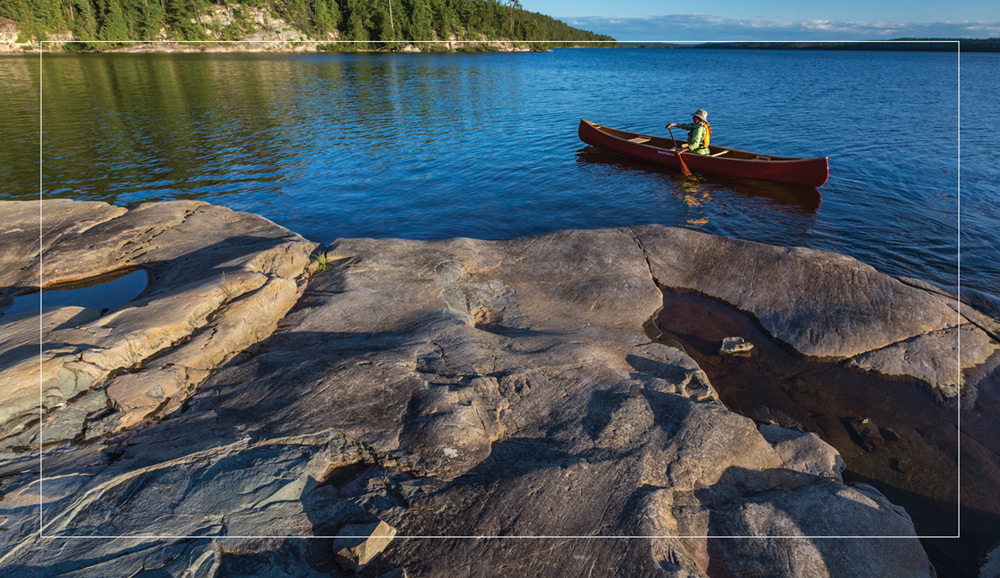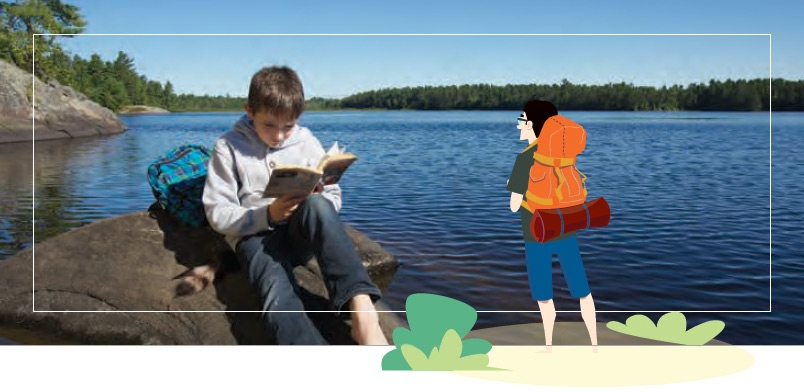Healthy Parks Healthy People
Engage
Our Nature Our Health
Imagine a special place that would help lower your risk of heart attack by 50%. Imagine if this place also helped lower your risk of diabetes. Would you visit? Would you take your family with you?
What if that special place also helped reduce the risk of mental health challenges and:
- improved sleep
- increased productivity
- lowered stress
- increased self-esteem
When children visit this place, they have better test scores, reduced obesity, increased self-worth, and for children with ADHD, reduced symptoms.
As an added bonus, this place also cleans the water you drink and the air you breathe. It provides homes for wildlife.
Are you interested?

There is a rapidly growing body of scientific and health literature that shows spending time in nature has measurable positive benefits on your health.
Coming from this scientific evidence is a global movement called Healthy Parks Healthy People. At Ontario Parks, we are proud to be part of this movement. It’s our goal to improve the health and wellness of Ontarians by connecting them to nature. But we can’t do it alone. It will take partners in the health and environment sectors, as well as regular Ontarians to fully realize the vision of Healthy Parks Healthy People (HPHP).
Here’s why we think Healthy Parks Healthy People matters and why Ontario Parks is leading the way.
Why we think HPHP matters: The Concern
In 1920, only five in ten Canadians lived in cities. But today eight in ten Canadians are city dwellers. In 1976, 38% of Ontarians lived in the Greater Toronto Area (GTA) alone. This is expected to jump to over 50% by 2040. The drive to urbanization has two consequences—natural areas are reduced to make room for development and Ontarians are exposed less often to natural areas because they need to travel further to reach them. This raises the alarm when we realize how crucial the nature connection is to our health and well-being. Author Richard Louv coined the term “nature deficit disorder” to describe the human costs of alienation from the natural world.
The loss of our connection to nature not only hurts our health and well-being, it also hurts our bank account. In Canada the total spending on health has grown from 7% of Gross Domestic Product (GDP) in 1975 to 11% in 2016. This amounts to a staggering $226 billion or over $6,000 per person. This is due in part to an aging population but the increase in chronic disease plays a major role.
In Canada, the rate of chronic disease is rising by an alarming 14% per year. Our lifestyle choices are driving this epidemic—inactivity and poor eating choices lead to obesity, the major cause of chronic disease. This comes with a big price tag. Treatment of chronic disease consumes 67% of all direct health care costs. The cost to the Canadian economy is $190 billion annually; $68 billion is from treatment and the rest is the cost of lost productivity and absenteeism.
In Canada, anxiety and mood disorders are on the rise; 12% of adult Canadians have a diagnosed anxiety or mood disorder. Young people are not immune; rates are also rising among children and youth. Along with mental health challenges come stigma, social isolation and lost productivity. Disconnection from nature may be one of the causes. Evidence is emerging that green space can be both preventative and restor-ative for mood disorders, and as humans we need exposure to green space for optimal cognitive function.

 Health is a state of complete physical, mental and social well-being and not merely the absence of disease or infirmity.
Health is a state of complete physical, mental and social well-being and not merely the absence of disease or infirmity.- Constitution of the World Health Organization
Only 9% of Canadian kids aged 5 to 17 get the 60 minutes of heart-pumping activity they need each day. Seventy-six percent (76%) are getting more daily screen time than what is recommended. Childhood obesity is setting the stage for future chronic disease. The current generation of kids may be the first generation in recent memory to have a shorter expected lifespan than their parents.
Play, and play outside in nature in particular, have been identified as a key solutions to this health challenge. In Canada, a diverse group of partners and researchers have examined the evidence and developed a position statement on outdoor play. “Access to active play in nature and outdoors—with its risks—is essential for healthy child development.”

Why we think HPHP matters: Nature is critical to good health and well-being
Even ancient Greek philosophers such as Hippocrates recognized the healing power of nature; vis medicatrix naturae. In Japan, Shinrin Yoku (forest bathing), although a relatively new term, respects the traditional understanding of the therapeutic value of nature. Within the Americas, including Ontario, many indigenous cultures have long understood the healing value of nature.
The large and growing evidence from science is telling us what we have long understood… nature is not only good for our health and well-being; it’s essential. This evidence comes from many different fields of study including psychology, ecology, public health and disease management. The evidence links time spent in nature to a wide variety of health benefits, including physical, mental, spiritual, and social.
Could Ontario Parks be part of the solution to the health crisis facing society?
How much nature do we need?
Any time spent in nature provides health benefits. But as you move along the nature continuum from built environments to more natural environments, not only does the quality of nature increase but so do the corresponding health benefits.
The more time you spend in the natural environment, the bigger the nature dose and the larger the health benefits. Likewise, the better the quality of the nature experience, the larger the health bene-fits. The houseplant on the side of your desk gives you a mini dose of nature, the park at the end of the street gives you a medium dose and a provincial park gives you a larger dose.
 We as Indigenous people view nature as a balance of life. Many in today’s modern society view nature as a place to relax and find them-selves, as well as a way to maintain their own identity and means of life. So we all have that connection with nature. Being in solitude in nature really opens your mind and puts you in a relaxed state; enjoying the landscape, watching wildlife and looking at the stars at night. We all have a spiritual connection with the land. This connection is not so much one of ownership but one of stewardship. If that connection is lost, then the spiritual well-being of all people will be at stake. So we all need to keep that connection with nature, it gives us a positive feeling, not just towards ourselves but towards each other and to what really surrounds us, which is nature itself.
We as Indigenous people view nature as a balance of life. Many in today’s modern society view nature as a place to relax and find them-selves, as well as a way to maintain their own identity and means of life. So we all have that connection with nature. Being in solitude in nature really opens your mind and puts you in a relaxed state; enjoying the landscape, watching wildlife and looking at the stars at night. We all have a spiritual connection with the land. This connection is not so much one of ownership but one of stewardship. If that connection is lost, then the spiritual well-being of all people will be at stake. So we all need to keep that connection with nature, it gives us a positive feeling, not just towards ourselves but towards each other and to what really surrounds us, which is nature itself.- Alexander Wanakameg (Whitesand First Nation)
What is Healthy Parks Healthy People?
Healthy Parks Healthy People is a world-wide movement that recognizes the fundamental link between human health and healthy ecosystems.
Healthy Parks Healthy People was launched by Parks Victoria (Australia) in 2000 to encourage the connections between a healthy environment and healthy society. Backed by a growing body of evidence, HPHP has expanded and is receiving global attention. In 2010, Parks Victoria hosted the first International Healthy Parks Healthy People Congress, which brought together over 1,200 delegates from 37 nations to explore the many ways nature and parks significantly contribute to human health and well-being. Many parks organizations across the globe are now part of the HPHP movement including the U.S. National Parks Service, South Africa National Parks, Metsähallitus Natural Heritage Services, Finland, and the Department of Conservation New Zealand to name a few.
Ontario Parks joined the movement in 2013 and launched its first initiatives in 2015; this included engaging partners, a promotional campaign, special events for park visitors and encouraging new research.
Why should Ontario Parks lead the way on Healthy Parks Healthy People?
There are many types of green space in Ontario ranging from backyards, to urban parks, to provincial and national parks. All of these places offer green health benefits. But Ontario Parks sits in a unique position to lead the charge to connect nature with health and well-being for Ontarians.
From the very beginning, health had a role in the mandate of provincial parks. Algonquin, created in 1893, was established in part “To serve as a sanitarium or place of health resort.”
References
The foundation of this document is a research review conducted by Ontario Parks; Healthy Parks Healthy People: A discussion paper.
The following additional references were used to develop this document:
Africa, J., Logan, A., Mitchell, R., Korpela, K., Allen, D., Tyrväinen, L., Nisbet, E., Li, Q., Tsunetsugu, Y., Miyazaki, Y., Spengler, J.; on behalf of the NEI Working Group. Center for Health and the Global Environment at the Harvard School of Public Health (2014). The Natural Environments Initiative: Illustrative Review and Workshop Statement.
Conference Board of Canada (2017). Demography is Destiny. Health Spending Prospects for Ontario.
Canadian Institute for Health Information (2016). National Health Expenditure Trends, 1975 to 2016. Ottawa, ON: CIHI.
Conference Board of Canada (2015). Moving Ahead. Taking Steps to Reduce Physical Inactivity and Sedentary Behaviour.
Ipsos Public Affairs for Ontario Parks (2016). Car Camping Final Report.
Mental Health Commission of Canada (2015). Informing the Future: Mental Health Indicators for Canada.
Parks Canada (2014). Connecting Canadians with Nature—An Investment in the Well- Being of our Citizens. Ottawa, ON: Parks Canada. 36 pp.
ParticipACTION (2015). The Biggest Risk is Keeping Kids Indoors. The PacticipACTION Report Card on Phyisical Activity for Children and Youth.
Public Health Agency of Canada (2016). How Healthy are Canadians? A trend analysis of the health of Canadians from a health living and chronic disease perspective.
Public Health Ontario (2013). Addressing Obesity in Children and Youth: Evidence to Guide Action for Ontario.
Sandifer, P.A., Sutton-Grier, A.E., and Ward, B.P. (2015). Exploring connections among nature, biodiversity, ecosystem services, and human health and well-being: Opportunities to enhance health and biodiversity conservation. Ecosystem Services 12 (2015).
Townsend, M, Henderson-Wilson, C, Warner, E, and Weiss, L (2015). Healthy Parks, Healthy People: The state of the evidence 2015. Prepared for Parks Victoria by authors in the School of Health and Social Development, Deakin University.
Tremblay et al., (2015). Position Statement on Active Outdoor Play. International Journal of Environmental Research and Public Health, 12, 6475-6505.
WHO, 1946. Preamble to the Constitution of the World Health Organization as adopted by the International Health Conference, New York, 19–22 June, 1946; signed on 22 July 1946 by the representatives of 61 States (Official Records of the World Health Organization, No.2, p. 100) and entered into force on 7 April 1948. World Health Organization.
WHO and SCB (2015). Connecting Global Priorities: Biodiversity and Human Health: A State of Knowledge Review. Published by the World Health Organization and Secretariat of the Convention on Biological Diversity.
Reading List
Want to read further about the connection between health and nature? This is small sample of the many resources you may be interested in.
Connecting Canadians to Nature, Canadian Parks Council, 2014.
A Guide to Healthy Parks Healthy People, Parks Victoria, 2017.
Last Child in the Woods; Saving our children from nature-deficit disorder, Richard Louv, 2005.
The Nature Fix; Why Nature Makes Us Happier, Healthier, and More Creative, Florence Williams, 2017.
The Nature Playbook, Canadian Parks Council, 2016.
The Nature Principle: Human Restoration and the End of Nature-Deficit Disorder, Richard Louv, 2011.
Your Brain on Nature, Eva M. Selhub MD and Alan C. Logan ND, 2012.

Join us on
July 18, 2025
Free day use in all Provincial Parks

These health benefits are real, but they don’t just happen in one special place. These are some of the very real and well-studied benefits that all nature can provide.

Canadians spend more time indoors now than any other point in history— 90% of each day.
90%

We spend 69% of our waking time sitting.
69%
Humans are hard-wired to be connected to nature
Many experts agree that humans are designed to be in nature. Over 99% of human history was spent living closely with other animals and plants, and we have a desire to seek connections with the natural world. The well-being we feel in nature has been hard-wired into our genes through evolution. This concept is known as biophilia.
Given the long history that humans have been immersed in nature and the relatively short time that we have removed ourselves from nature, is it no wonder that we are suffering health problems? We are working against our basic design when we spend too much time inside.
Some of the proven health benefits of time spent in nature:

Psychological
Positive effect on mental health
- Decreased depression/stress
- Increased self-esteem
- Improved mood
- Increased creativity
- Increased happiness
- Reduced ADHD in children

Cognitive
Positive effect on cognitive ability
- Better attention-span
- Reduced mental fatigue
- Improved academic performance
- Improved cognitive function in adults & children
- Improved productivity

Physiological
Positive effect on physical health
- Better general health & well-being for adults & children
- Lower stress
- Lower blood pressure
- Reduced mortality from chronic diseases
- Reduced headaches/pain
- Reduced obesity
- Faster recovery from surgery/illness/trauma
- Improved addiction recovery
- Reduced cardiovascular and respiratory disease
- Increased levels of natural killer cells and anti-cancer proteins
- Decreased Type 2 diabetes
- Increased longevity

Social/Spiritual
Positive effect on social and spiritual well-being
- Improved social interaction
- Social empowerment
- Reduced aggression, crime rates, violence, fear
- Enhanced spiritual well-being

Increased Resiliency
Personal and community ability to withstand impacts and remain healthy
- Pro-environment awareness and behaviour
- Nature supplies services like clean water and air that support health and well-being
